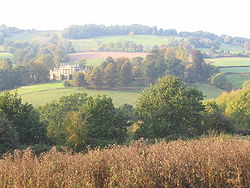Shockerwick House: Difference between revisions
m Dating maintenance tags: {{Dn}} |
dab Charles Morley to Charles Morley (MP) |
||
| Line 33: | Line 33: | ||
The site was a manor prior to its purchase in 1740, from the estate of Anthony Carew,<ref>{{cite web|title=Shockerwick House|url=http://www.bathfordsociety.org.uk/content/buildings/shockerwick_house_main.htm|publisher=Bathford Society|accessdate=22 December 2012}}</ref> by the Wiltshire family. The Wiltshires commissioned [[John Wood, the Elder]] to design the house and grounds. [[Thomas Gainsborough]] was a frequent visitor and painted several canvases in the orangery of the house including that of Edward Orpin, Parish Clerk of Bradford-upon-Avon which is now in the [[Tate]].<ref>{{cite web|title=Edward Orpin, Parish Clerk of Bradford-upon-Avon|url=http://www.tate.org.uk/art/artworks/hone-edward-orpin-parish-clerk-of-bradford-upon-avon-n00760|publisher=Tate Gallery|accessdate=22 December 2012}}</ref> Another visitor was [[William Pitt the Younger]] who was at Shockerwick when he heard about [[Napoleon]]'s victory at the [[Battle of Austerlitz]].<ref name=parks>{{cite web|title=Shockerwick House, Bath, England |url=http://www.parksandgardens.org/places-and-people/site/2969|work=Parks and Gardens UK|publisher=Parks and Gardens Data Services Ltd|accessdate=9 June 2013}}</ref> |
The site was a manor prior to its purchase in 1740, from the estate of Anthony Carew,<ref>{{cite web|title=Shockerwick House|url=http://www.bathfordsociety.org.uk/content/buildings/shockerwick_house_main.htm|publisher=Bathford Society|accessdate=22 December 2012}}</ref> by the Wiltshire family. The Wiltshires commissioned [[John Wood, the Elder]] to design the house and grounds. [[Thomas Gainsborough]] was a frequent visitor and painted several canvases in the orangery of the house including that of Edward Orpin, Parish Clerk of Bradford-upon-Avon which is now in the [[Tate]].<ref>{{cite web|title=Edward Orpin, Parish Clerk of Bradford-upon-Avon|url=http://www.tate.org.uk/art/artworks/hone-edward-orpin-parish-clerk-of-bradford-upon-avon-n00760|publisher=Tate Gallery|accessdate=22 December 2012}}</ref> Another visitor was [[William Pitt the Younger]] who was at Shockerwick when he heard about [[Napoleon]]'s victory at the [[Battle of Austerlitz]].<ref name=parks>{{cite web|title=Shockerwick House, Bath, England |url=http://www.parksandgardens.org/places-and-people/site/2969|work=Parks and Gardens UK|publisher=Parks and Gardens Data Services Ltd|accessdate=9 June 2013}}</ref> |
||
In the 1880s the house was bought by [[Charles Morley |
In the 1880s the house was bought by [[Charles Morley (MP)|Charles Morley]] the [[Member of Parliament]] for [[Breconshire (UK Parliament constituency)|Breconshire]].<ref name=parks/> The house was altered in 1896 by [[Ernest George]] and [[Alfred B. Yeates]]. <ref name="IoE"/> The Morley family owned the house until 1955. In 1961 it was bought by [[Henry Pelham-Clinton-Hope, 9th Duke of Newcastle]] who sold it in 1970 to the [[W.D. & H.O. Wills]] tobacco company who used it as a training centre.<ref name=parks/> |
||
[[File:Shockerwick House in 1790.jpg|thumb|Shockerwick House. Ink wash on paper by [[Samuel Hieronymus Grimm]] in 1790]] |
[[File:Shockerwick House in 1790.jpg|thumb|Shockerwick House. Ink wash on paper by [[Samuel Hieronymus Grimm]] in 1790]] |
||
Revision as of 10:16, 1 September 2013
| Shockerwick House | |
|---|---|
 | |
| Location | Bathford, Somerset, England |
| Built | c. 1750 |
Listed Building – Grade I | |
| Designated | 1 February 1956[1] |
| Reference no. | 32269 |
Shockerwick House in Bathford, Somerset, England was built as a manor house around 1750 by John Wood, the Elder. It has been designated as a Grade I listed building.[1] It is set in 7.7 hectares (19 acres) of parkland[2] within the Bybrook River valley.
The site was a manor prior to its purchase in 1740, from the estate of Anthony Carew,[3] by the Wiltshire family. The Wiltshires commissioned John Wood, the Elder to design the house and grounds. Thomas Gainsborough was a frequent visitor and painted several canvases in the orangery of the house including that of Edward Orpin, Parish Clerk of Bradford-upon-Avon which is now in the Tate.[4] Another visitor was William Pitt the Younger who was at Shockerwick when he heard about Napoleon's victory at the Battle of Austerlitz.[2]
In the 1880s the house was bought by Charles Morley the Member of Parliament for Breconshire.[2] The house was altered in 1896 by Ernest George and Alfred B. Yeates. [1] The Morley family owned the house until 1955. In 1961 it was bought by Henry Pelham-Clinton-Hope, 9th Duke of Newcastle who sold it in 1970 to the W.D. & H.O. Wills tobacco company who used it as a training centre.[2]

Since 1983 it has been used as a Nursing Home and is run by Bupa.[5]
See also
References
- ^ a b c "Shockerwick House". Images of England. English Heritage. Retrieved 2009-07-19.
- ^ a b c d "Shockerwick House, Bath, England". Parks and Gardens UK. Parks and Gardens Data Services Ltd. Retrieved 9 June 2013.
- ^ "Shockerwick House". Bathford Society. Retrieved 22 December 2012.
- ^ "Edward Orpin, Parish Clerk of Bradford-upon-Avon". Tate Gallery. Retrieved 22 December 2012.
- ^ "Shockerwick House Residential and Nursing Home". BUPA. Retrieved 22 December 2012.

